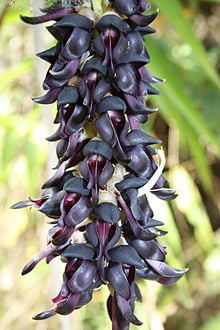Mucuna pruriens

Mucuna pruriens is a tropical legume native to Africa and tropical Asia and widely naturalized and cultivated.[2] Its English common names include monkey tamarind, velvet bean, Bengal velvet bean, Florida velvet bean, Mauritius velvet bean, Yokohama velvet bean, cowage, cowitch, lacuna bean, and Lyon bean.[2] The plant is notorious for the extreme itchiness it produces on contact,[3] particularly with the young foliage and the seed pods. It also produces many medium-sized red swollen across your contact area of skin that is actively itchy. It has agricultural and horticultural value and is used in herbalism.
The plant is an annual climbing shrub with long vines that can reach over 15 metres (50 ft) in length. When the plant is young, it is almost completely covered with fuzzy hairs, but when older, it is almost completely free of hairs. The leaves are tripinnate, ovate, reverse ovate, rhombus-shaped or widely ovate. The sides of the leaves are often heavily grooved and the tips are pointy. In young M. pruriens plants, both sides of the leaves have hairs. The stems of the leaflets are two to three millimeters long (approximately one tenth of an inch). Additional adjacent leaves are present and are about 5 millimetres (0.2 in) long.
The flower heads take the form of axially arrayed panicles. They are 15–32 centimetres (6–13 in) long and have two or three, or many flowers. The accompanying leaves are about 12.5 millimetres (0.5 in) long, the flower stand axes are from 2.5–5 millimetres (0.1–0.2 in). The bell is 7.5–9 millimetres (0.3–0.4 in) long and silky. The sepals are longer or of the same length as the shuttles. The crown is purplish or white. The flag is 1.5 millimetres (0.06 in) long. The wings are 2.5–3.8 centimetres (1.0–1.5 in) long.
In the fruit-ripening stage, a 4–13 centimetres (2–5 in) long, 1–2 centimetres (0.4–0.8 in) wide, unwinged, leguminous fruit develops. There is a ridge along the length of the fruit. The husk is very hairy and carries up to seven seeds. The seeds are flattened uniform ellipsoids, 1–1.9 centimetres (0.4–0.7 in) long, .8–1.3 centimetres (0.3–0.5 in) wide and 4–6.5 centimetres (2–3 in) thick. The hilum, the base of the funiculus (connection between placenta and plant seeds) is a surrounded by a significant arillus (fleshy seed shell).
M.pruriens bears white, lavender, or purple flowers. Its seed pods are about 10 cm (4 inches) long[4] and are covered in loose, orange hairs that cause a severe itch if they come in contact with skin. The itch is caused by a protein known as mucunain.[5] The seeds are shiny black or brown drift seeds.
The dry weight of the seeds is 55–85 grams (2–3 oz)/100 seeds.[6]
